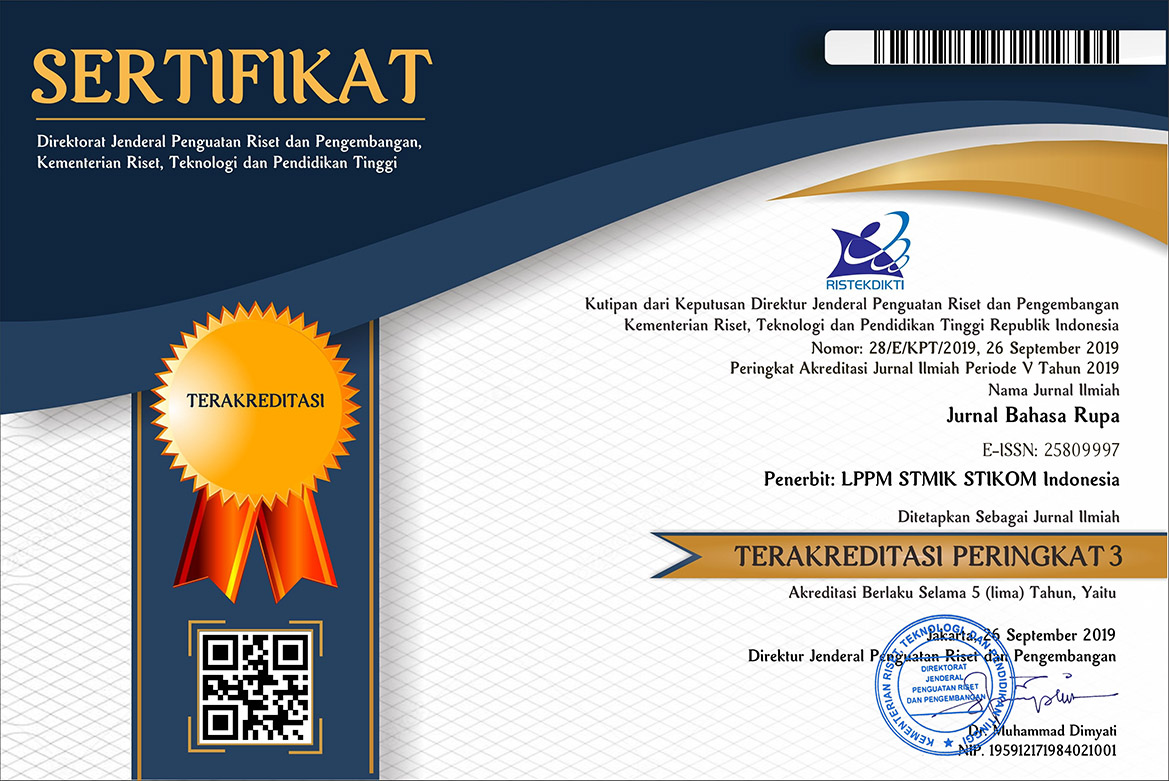ANIMASI 3 DIMENSI SEBAGAI SARANA SOSIALISASI PENTINGNYA KECERDASAN EMOSIONAL DALAM KEHIDUPAN REMAJA
DOI:
https://doi.org/10.31598/bahasarupa.v3i1.436Kata Kunci:
Emotional Intelligence, Socialization, 3D Animation, Teenagers, hopelessnessAbstrak
In general, every human being must face problems and trials of life. There are various kinds of problems that come in life, do not know when, where and how these problems come. In dealing with problems, humans have their own ways to overcome these problems. There are those who give up easily and some who can overcome them. In this case the role of emotional intelligence is very important. Especially at the age of adolescence sometimes difficult to control emotions in themselves, resulting in a sense of hopelessness. Therefore, it is necessary to design a media that can be used to socialize the importance of emotional intelligence in adolescent life. The results showed that the concept that was appropriately used to socialize the importance of emotional intelligence in adolescents' lives was the concept of "Emotional Spirit". This concept was chosen to fit the objectives of this socialization as well as the intended target of youth. This 3D animated story was taken based on the true story of a teenager who was able to survive for 49 days in the middle of the ocean. In order for the socialization to run effectively, supporting media such as social media, posters, packaging, t-shirts, roll-up banners, stickers, tote bags and key chains are made. Through the design of the socialization media in the form of 3D animation along with its supporting media, it is expected that the target audience, namely adolescents, can better control their emotions when facing problems.Unduhan
Referensi
Masrur, Abdullah dan Marhijanto, Bambang. Mendorong Daya Kemauan. Penerbit CV Bintang Remaja, 2000
G. P. Putra Adnyana Yasa dan C. D. Surya Ambara. Modeling dan Animasi Dengan Autodesk Maya 2014. Penerbit STD Bali, 2018
I. N. Agus Suarya Putra and I. P. Adi Saputra, “Perancangan Media Informasi Program Studi Teknik Informatika Dan Sistem Komputer Pada STMIK STIKOM Indonesia Berbasis Animasi 2Dâ€, Jurnal Bahasa Rupa, vol. 1, no. 1, pp. 17-24, Oct. 2017.
Kurniadi, Adi. Membuat Dunia 3D dengan VRML. Penerbit Elex Media Komputindo, 1999
B. Muhdaliha and D. R. D. Batuaya, “Film Animasi 2 Dimensi Cerita Rakyat Bali Berjudul I Ceker Cipakâ€, Jurnal Bahasa Rupa, vol. 1, no. 1, pp. 61-72, Oct. 2017.
B. Takwin, Akar-Akar Ideologi: Pengantar Kajian Konsep Ideologi dari Plato hingga Bourdieu, Yogyakarta: Jalasutra, 2009.
A. Y. Lubis, Postmodernisme: Teori dan Metode, Jakarta: Rajawali Pers, 2014.
G. Prakosa, Animasi: Pengetahuan Dasar Film Animasi Indonesia, Jakarta: Yayasan Visual Indonesia (Nalar), 2010.
Kusrianto, Adi. Pengantar Desain Komunikasi Visual. Yogyakarta: Penerbit Andi Yogyakarta, 2007
Supriyono, Rakhmat. Desain Komunikasi Visual Teori dan Aplikasi. Yogyakarta: Penerbit Andi Yogyakarta, 2010
##submission.downloads##
Diterbitkan
Terbitan
Bagian
Lisensi
The author's copyright in the Bahasa Rupa Journal, assigns that the publication of published articles is owned by the editorial board with the author's approval, but the rights are still with the author. The legal rules for accessing digital electronic articles are under license  Attribution-NonCommercial-ShareAlike 4.0 International (CC BY-NC-SA 4.0), which means that the Bahasa Rupa Journal has the right to store, modify, manage databases, maintain and publish articles without the author's permission, but the author as the copyright holder is still written as it is. Articles published in Bahasa Rupa Journals, both in hard and soft copy forms are available as open access, for educational, research and library purposes, and beyond that purpose, the editorial board of the Language and Language Journal is not responsible for illegal copyright infringement. This journal also applies LOCKSS and CLOKSS archiving.
Attribution-NonCommercial-ShareAlike 4.0 International (CC BY-NC-SA 4.0), which means that the Bahasa Rupa Journal has the right to store, modify, manage databases, maintain and publish articles without the author's permission, but the author as the copyright holder is still written as it is. Articles published in Bahasa Rupa Journals, both in hard and soft copy forms are available as open access, for educational, research and library purposes, and beyond that purpose, the editorial board of the Language and Language Journal is not responsible for illegal copyright infringement. This journal also applies LOCKSS and CLOKSS archiving.













.png)





